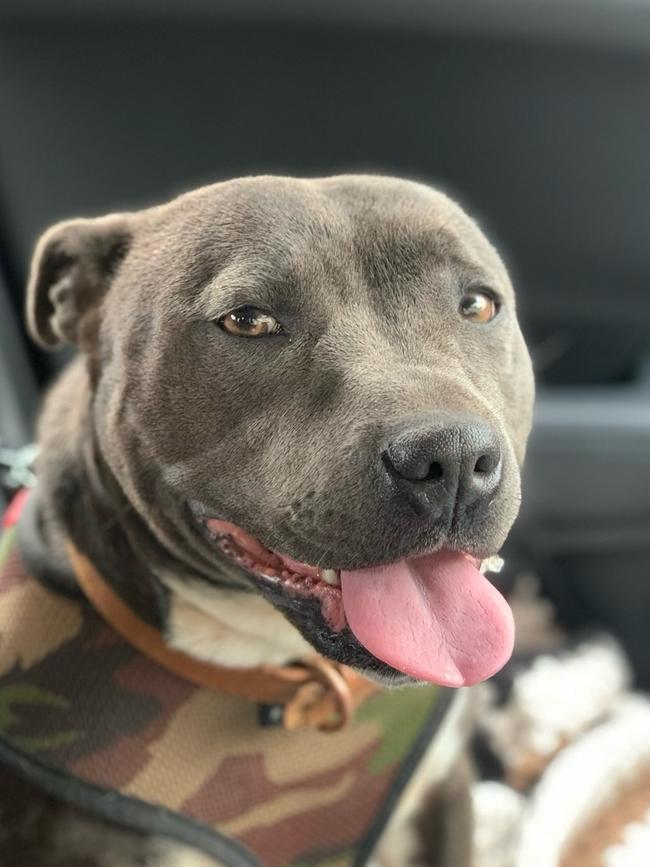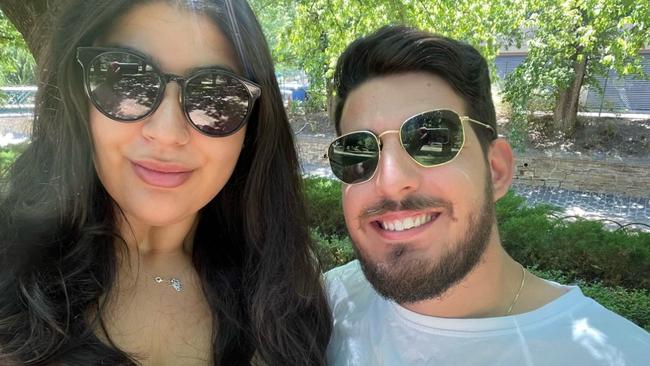Melbourne couple’s dogs die after deadly snake bite
The death of two dogs after a deadly snake attack in their backyard has prompted a timely warning and advice from a vet on what to do.
Animals
Don't miss out on the headlines from Animals. Followed categories will be added to My News.
A grieving Melbourne dog owner has issued a heartfelt warning about snakes after she discovered her two pets had died in her backyard after being bitten.
Jessica Cefala, of Taylors Lakes in Melbourne’s northwest, was in tears as she relived the moment she found her two dogs, a Pekingese cross mini Shih tzu Zara and purebred blue English staffy Luna, lifeless after being bitten on Sunday.
“We went out for the day. We made sure they had water and food. We had gotten home after a few hours and they would normally be at our front gate waiting for us,” she said.
“I thought something wasn’t right. I went into the backyard calling them but they weren’t responding. Then I found Luna and she was laying on the ground, not responding.
“I said ‘I think the dogs are dead’.


“My fiance went to look and came back in tears and said they were both gone.
“It was too late, they weren’t breathing or anything.”
Ms Cefala said her brother later found an eastern brown snake in their yard with a bite on it, which likely came from her dogs. She estimated it was about 1.7m long.
The average length of brown snakes are 1.5m but they can grow up to 2.4m long, with males larger than females, according to Wildlife Victoria.
The deadly attack came eight months after Zara was hospitalised following a snake bite by the same species in February.

Ms Cefala said her only comfort was that they died together, explaining: “I don’t think that either of them could have lived without they other”.
She said dog owners should be super careful at this time of year and “not leave them outside if you’re not home”.
“In the area we live in, we have a children’s playground right next to a creek. There have been snakes in the playground. You’re never going to be able to stop them but be really careful where you’re stepping,” Ms Cefala said.
Ms Cefala said they had taken steps to minimise the risk of snakes entering their property by plugging gaps in fences but said they back onto a train line, where there is tall grass and rubbish that can attract them.

Snake Catchers Victoria expert Barry Goldsmith said it was common for snakes to be more active coming out of winter.
“All Victorian snakes are venomous but there are four species that are dangerous: tigers, blacks, copperheads and brown,” he said.
He said if people come across a snake, they should stand still or move slowly backwards, and he encouraged pet owners to do snake aversion training.
“If you can’t do that, provide a snake-proof areas where your dog can do its thing, where you don't have to worry about snakes. Anywhere a mouse can go, a snake can do – so you need to think like that.,” he said.
“It doesn’t matter where you are in Australia, you’re never more than half a kilometre from a snake. Snakes can crops up anywhere. I’ve been called into Bourke St in the CBD, to Brighton and other places – anywhere where there is old established homes with mice or bushy gardens.
He said people should avoid touching snakes if they come across them and pleaded for concerned Aussies to not try and kill the reptile but to call their local snake catcher.
SNAKE BITES: SYDNEY VET’S ADVICE
Southern Cross Vet founder Dr Sam Kovac said snake venom was a poison and without treatment 95 per cent of cats and dogs die.
But how quickly it travels through their systems is not an exact science.
“With most poisons, the smaller the body affected with the same dose of venom, the greater the lethality of it. Not so with snake bite,” Dr Kovac said.
“It depends on the individual pet and we don’t know why some go downhill so fast and others seem resistant. You could have a jack russell bitten by a snake who only shows signs within a few hours, and a Great Dane could be bitten by the same snake and show signs within half an hour. So just because you’ve got a large dog, doesn’t mean they’re less likely to die.”
Dr Kovac said snake venom worked in different ways, depending on what toxins were injected.
“Snake toxin has many toxins but the three biggies are neurotoxin, myotoxin and haemotoxin. Depending on which cocktail your pet received from the bite, the symptoms vary,” he said.
“With the neurotoxin, seizures, twitching, paralysis and droopy face are all a sign. With the myotoxin, weakness, muscle pain when touched and pigmented colour pee (reddish purple). With the haemotoxin, look our for signs of bleeding anywhere, little bruises on the gums, heavy difficult breathing – as no oxygen in blood – yellow-coloured whites of the eye, pale coloured gums.”
Snake bite marks can be tricky to spot, Dr Kovac said.
“Snakes teeth are like needles and even if you clip all the fur off your pet you won’t be seeing a prominent bite mark,” he said,
He said it was common at this time of year for snakes to be more active, and expects this summer to be worse than previous years because of El Nino conditions.
“Snakes are cold blooded - this means they can’t regulate their temperature and it depends on the environment. So when it’s cool, they’re cool and much less active, but when it’s warm, they come alive and are much more energetic. With this increased energy when it’s warm, so too does their calorie requirements increase, and they hunt more aggressively to ensure they don’t starve,” Dr Kovac said.
“In every Spring/Summer snakes are more active, but this summer is being characterised by an El Nino event, bringing much higher than normal temperatures. The last two years we’ve had La Nina which is the opposite and have seen much fewer snakes than normal, so the entire of Australia will need to be prepared to get more encounters with snakes from now until around March next year.”
Dr Kovac said animal behaviour could be a useful indicator as to whether a snake was nearby.
“You may see other dogs barking in an unusual tone, cats prowling, increased activity of wild birds or pet birds making a lot of noise - birds hate snakes,” he said.





